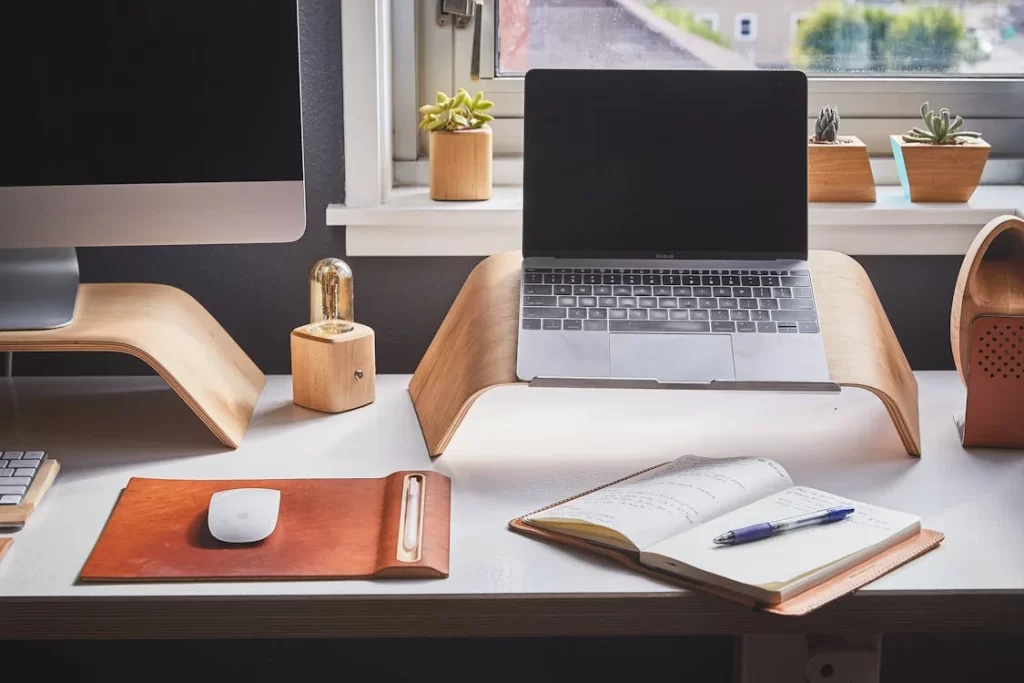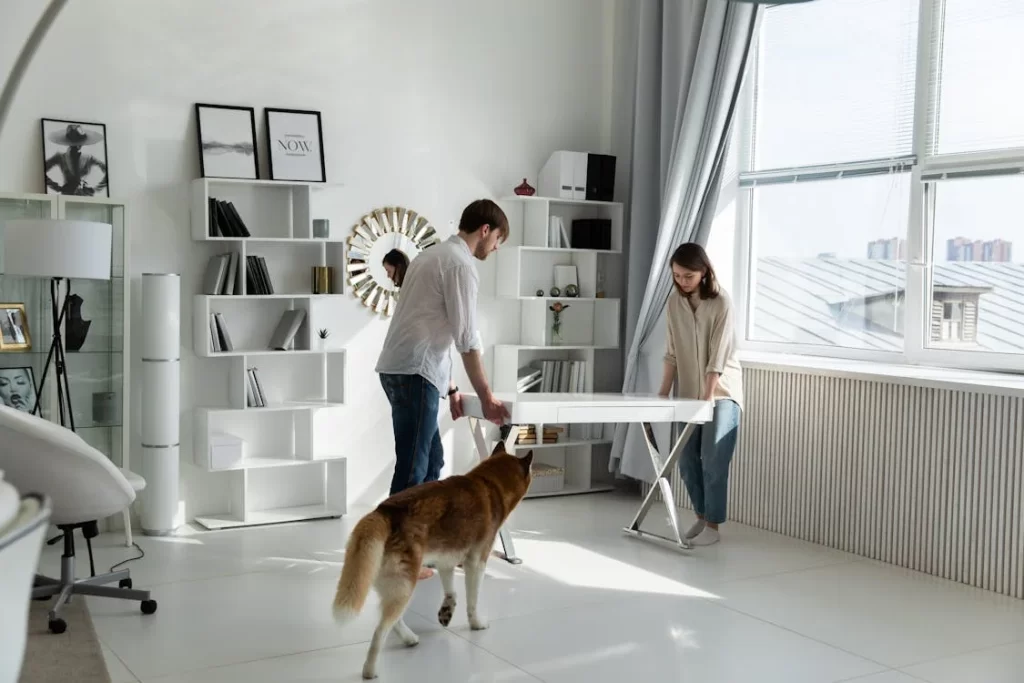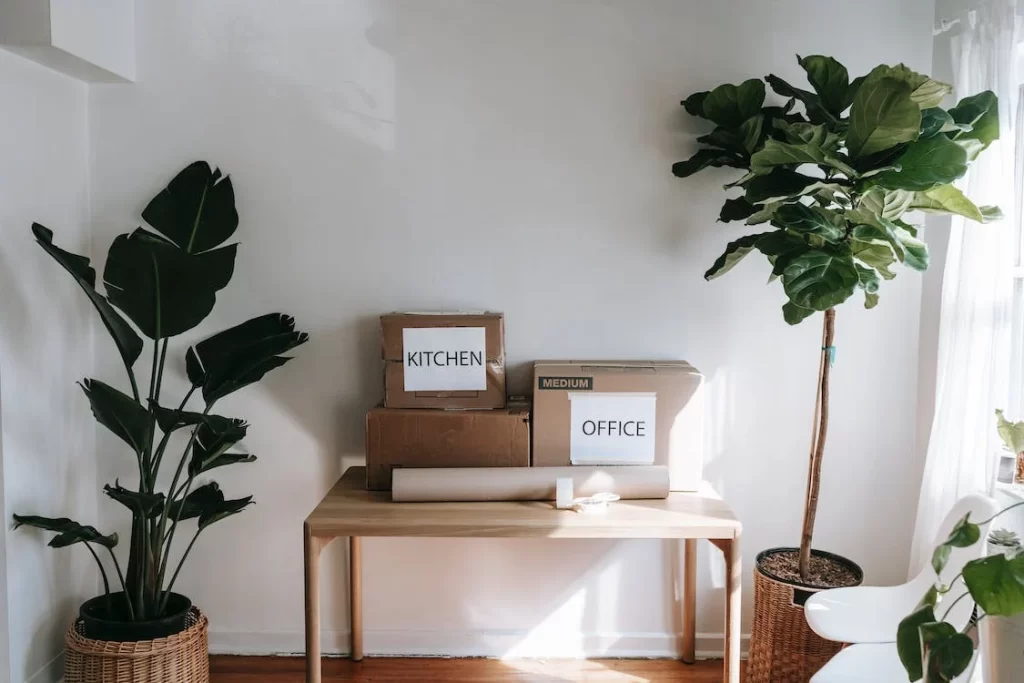Table of Contents
Relocating a home office involves more than just moving furniture and equipment. It’s about creating an environment that fosters productivity, comfort, and efficiency. This guide provides comprehensive home office relocation tips to help you set up a productive workspace after your move.
Planning Your Home Office Relocation
Assess Your New Space
Home office organization after a move begins with assessing your new space. Understand the dimensions, natural light sources, and layout options. This assessment helps in planning the placement of furniture and equipment efficiently.
Key Considerations:
- Space Measurement: Measure the room to ensure your furniture fits comfortably.
- Lighting: Identify natural light sources and consider where artificial lighting will be needed.
- Ventilation: Ensure the space is well-ventilated to maintain a comfortable working environment.
- Noise Levels: Determine the noise levels in different parts of your new home to choose the quietest location for your home office.
- Access to Power Outlets: Identify where power outlets are located and plan your furniture arrangement accordingly to avoid using excessive extension cords.
Create a Layout Plan
A well-thought-out layout plan is crucial for an ergonomic home office setup. Sketch a layout that optimizes space and minimizes distractions. Consider the placement of your desk, chair, storage units, and other essentials.
Layout Tips:
- Desk Placement: Position your desk to take advantage of natural light while avoiding glare on your computer screen.
- Ergonomic Setup: Ensure your chair, desk, and monitor are positioned to support good posture.
- Storage Solutions: Incorporate cabinets, shelves, and organizers to keep your workspace clutter-free.
- Flow of Movement: Ensure there is enough space to move around comfortably without bumping into furniture or equipment.
- Visual Appeal: Create a visually appealing layout by balancing functionality with aesthetics. This can help enhance your mood and productivity.

Moving and Setting Up Furniture
Disassembling and Packing
Disassemble your office furniture carefully, labeling each part to simplify reassembly. Use bubble wrap and padding to protect fragile items.
Packing Tips:
- Label Everything: Clearly label boxes and components to avoid confusion during unpacking.
- Protect Equipment: Use protective covers for electronic devices to prevent damage.
- Organize Cables: Bundle cables and cords neatly, labeling them for easy setup later.
- Use Quality Packing Materials: Invest in high-quality packing materials to ensure your items are well-protected during the move.
- Take Photos: Before disassembling complex setups, take photos to reference during reassembly. This can be especially helpful for wiring and cable management.
Unpacking and Reassembly
Unpack systematically, starting with the essentials. Assemble your desk and chair first, then move on to storage units and other furniture.
Unpacking Tips:
- Start with Essentials: Set up your desk and chair to establish a functional workspace immediately.
- Follow Labels: Use your labels to guide the reassembly process, ensuring everything is put together correctly.
- Check for Damage: Inspect each item for damage during the move and address any issues promptly.
- Arrange As You Unpack: Place items in their intended locations as you unpack to avoid clutter and streamline the setup process.
- Test Equipment: Ensure all electronic devices and equipment are functioning properly after reassembly.
Technology Setup for Home Office
Setting Up Computers and Devices
A technology setup for home office involves configuring your computer, printer, and other devices. Ensure all equipment is in working order and connected properly.
Key Steps:
- Reconnect Cables: Follow your labels to reconnect cables and power cords correctly.
- Check Connectivity: Ensure your internet connection is stable and fast.
- Update Software: Install any necessary updates for your operating system and applications.
- Backup Data: Ensure all important data is backed up before the move and verified after setup.
- Security Measures: Implement security measures such as antivirus software and secure passwords to protect your data.
Organizing Cables and Wires
Organized cables reduce clutter and prevent tripping hazards. Use cable organizers, clips, and labels to keep everything tidy.
Cable Management Tips:
- Use Cable Ties: Bundle cables together using zip ties or Velcro straps.
- Label Cables: Clearly label each cable to identify its purpose easily.
- Hide Cables: Use cable channels or sleeves to conceal cables along walls and under desks.
- Invest in a Cable Management System: Consider purchasing a cable management box or under-desk tray to keep cables out of sight.
- Regular Maintenance: Periodically check and reorganize cables to prevent tangling and maintain a neat appearance.
Ergonomic Home Office Setup
Choosing the Right Furniture
An ergonomic home office setup requires selecting furniture that supports good posture and reduces strain.
Furniture Selection Tips:
- Ergonomic Chair: Choose a chair with adjustable height, lumbar support, and comfortable padding.
- Adjustable Desk: Consider a desk that allows you to alternate between sitting and standing.
- Monitor Placement: Position your monitor at eye level to avoid neck strain.
- Supportive Accessories: Use ergonomic accessories such as keyboard trays, footrests, and monitor stands to enhance comfort.
- Quality Over Aesthetics: Prioritize quality and ergonomics over aesthetic appeal to ensure long-term comfort and productivity.
Setting Up Your Workspace
Arrange your workspace to maximize comfort and productivity. Ensure that your desk, chair, and monitor are positioned correctly.
Workspace Arrangement Tips:
- Desk Height: Adjust your desk height so that your elbows are at a 90-degree angle when typing.
- Chair Adjustment: Set your chair height so that your feet are flat on the floor and your knees are at a 90-degree angle.
- Monitor Distance: Position your monitor about an arm’s length away from your eyes.
- Keyboard and Mouse Placement: Place your keyboard and mouse at a comfortable distance to avoid reaching and strain.
- Lighting: Ensure adequate lighting, using desk lamps or overhead lights to reduce eye strain and enhance visibility.

Personalizing Your Home Office
Adding Personal Touches
Personalizing your home office can boost morale and productivity. Add items that inspire you and create a pleasant working environment.
Personalization Tips:
- Decor: Add artwork, photos, and plants to make your space feel more inviting.
- Comfort Items: Include items like cushions, throws, or a small fan for added comfort.
- Inspiration Board: Create a board with motivational quotes, goals, and reminders.
- Color Scheme: Choose a color scheme that reflects your personality and promotes a positive mood.
- Functional Decor: Select decor items that are both aesthetically pleasing and functional, such as stylish storage containers.
Organizing Your Space
A well-organized office enhances efficiency. Use storage solutions that keep your workspace tidy and free of distractions.
Organization Tips:
- Storage Bins: Use bins and baskets to keep supplies organized.
- File System: Implement a filing system for important documents to keep them easily accessible.
- Declutter Regularly: Regularly declutter your workspace to maintain a clean and efficient environment.
- Label Everything: Label storage bins, drawers, and files to quickly locate items.
- Digital Organization: Keep your digital files organized with a consistent naming and folder structure.
Enhancing Productivity in Your Home Office
Time Management Techniques
Effective time management is essential for maintaining productivity in your home office. Implement strategies that help you stay focused and efficient.
Time Management Tips:
- Set a Schedule: Establish a daily schedule with set working hours and breaks.
- Use a Planner: Keep a planner or calendar to track tasks and deadlines.
- Prioritize Tasks: Focus on high-priority tasks first to make the most of your productive hours.
- Time Blocking: Allocate specific blocks of time for different tasks to manage your workload effectively.
- Set Reminders: Use reminders and alarms to stay on track with your schedule.
Minimizing Distractions
Reducing distractions is crucial for maintaining a productive workspace. Identify common distractions and implement measures to minimize them.
Distraction Reduction Tips:
- Quiet Space: Choose a quiet area of your home for your office to minimize noise distractions.
- Do Not Disturb Sign: Use a sign to signal when you should not be disturbed.
- Tech-Free Zone: Designate areas of your workspace where electronic devices are not allowed.
- Manage Notifications: Turn off unnecessary notifications on your devices to avoid interruptions.
- Set Boundaries: Clearly communicate your work hours and boundaries to family members or housemates.
Maintaining Work-Life Balance
Creating Boundaries
Establishing boundaries between work and personal life is essential when working from home. Set clear boundaries to ensure a healthy work-life balance.
Boundary Setting Tips:
- Dedicated Workspace: Keep your workspace separate from living areas to create a physical boundary.
- Set Work Hours: Stick to regular work hours and avoid working outside these times.
- Communicate Boundaries: Inform family members of your work schedule and boundaries.
- End-of-Day Ritual: Develop a routine to signal the end of the workday, such as shutting down your computer or taking a walk.
- Work-Free Zones: Designate certain areas of your home as work-free zones to promote relaxation and personal time.
Taking Breaks
Regular breaks are vital for maintaining productivity and preventing burnout. Schedule short breaks throughout your day to rest and recharge.
Break Tips:
- Short Breaks: Take short breaks every hour to stretch and rest your eyes.
- Lunch Break: Ensure you take a full lunch break away from your desk.
- Exercise: Incorporate light exercise or stretching into your breaks to stay active.
- Mental Breaks: Engage in activities that relax your mind, such as reading, meditating, or listening to music.
- Hydration and Snacks: Keep healthy snacks and water at your desk to stay nourished and hydrated.

Final Touches and Continuous Improvement
Reviewing Your Setup
Regularly review your home office setup to ensure it continues to meet your needs. Make adjustments as necessary to enhance comfort and productivity.
Review Tips:
- Assess Comfort: Check your chair, desk, and monitor setup to ensure ongoing comfort.
- Evaluate Efficiency: Look for ways to streamline your workflow and reduce clutter.
- Seek Feedback: Ask for feedback from family members or colleagues to identify areas for improvement.
- Stay Updated: Keep up with the latest trends and technologies in home office setups to continually improve your workspace.
- Document Changes: Keep a record of adjustments and improvements made to track what works best for you.
Upgrading Equipment
Investing in quality equipment can significantly improve your home office experience. Upgrade your equipment as needed to maintain a high level of productivity.
Upgrade Tips:
- Monitor: Consider upgrading to a larger or higher-resolution monitor.
- Keyboard and Mouse: Invest in ergonomic keyboards and mice to reduce strain.
- Office Chair: Upgrade your office chair if it no longer provides adequate support.
- Lighting: Add or upgrade lighting fixtures to ensure optimal brightness and reduce eye strain.
- Technology: Stay updated with the latest technology advancements to enhance your productivity and efficiency.
Tips for Long-Term Success
Continuous Learning
Stay informed about the best practices and trends in home office setups. Continuous learning can help you adapt and optimize your workspace over time.
Learning Tips:
- Follow Experts: Follow home office setup experts and ergonomics specialists on social media and blogs.
- Online Courses: Take online courses on productivity, ergonomics, and home office organization.
- Webinars and Workshops: Attend webinars and workshops to learn from industry leaders and gain new insights.
- Books and Articles: Read books and articles on home office design and productivity to stay informed.
- Community Involvement: Join online communities or forums related to home office setups to exchange tips and advice with peers.
Networking and Support
Building a network of support can enhance your home office experience. Connect with other remote workers and professionals to share experiences and tips.
Networking Tips:
- Join Online Groups: Participate in online groups and forums for remote workers and home office enthusiasts.
- Attend Virtual Events: Attend virtual networking events and conferences to meet like-minded professionals.
- Mentorship: Seek mentorship from experienced remote workers who can provide guidance and support.
- Collaboration Tools: Use collaboration tools to stay connected with colleagues and industry peers.
- Social Media: Engage with others on social media platforms to build a network and exchange ideas.
Enhancing Your Well-Being
Physical Health
Maintaining physical health is crucial for long-term productivity and comfort in your home office.
Health Tips:
- Exercise Regularly: Incorporate regular exercise into your routine to stay active and healthy.
- Posture Awareness: Be mindful of your posture and make adjustments to prevent strain.
- Healthy Eating: Maintain a balanced diet and avoid excessive snacking.
- Hydration: Drink plenty of water throughout the day to stay hydrated.
- Stretching: Perform regular stretching exercises to prevent stiffness and improve circulation.
Mental Health
Supporting your mental health is equally important for maintaining a productive and positive home office environment.
Mental Health Tips:
- Mindfulness Practices: Practice mindfulness techniques such as meditation and deep breathing to reduce stress.
- Work-Life Balance: Ensure a healthy balance between work and personal life to avoid burnout.
- Breaks and Leisure: Take regular breaks and engage in leisure activities to relax and recharge.
- Support System: Maintain a support system of family, friends, and colleagues to share your experiences and challenges.
- Professional Help: Seek professional help if you experience ongoing stress or mental health issues.

A Productive Home Office: Your Key to Success
Creating a productive home office is a continuous process that requires planning, organization, and regular review. By following these home office relocation tips, you can set up a productive workspace that enhances your comfort, efficiency, and overall well-being.
Philadelphia Movers LLC: Your Partner in Home Office Relocation
Relocating your home office can be a daunting task, but Philadelphia Movers LLC is here to help. Our professional moving services ensure a smooth transition, allowing you to focus on setting up your ideal home office. Contact us today to schedule your move and take the first step towards a more productive and comfortable workspace. With our expertise, your home office relocation will be seamless and stress-free. Reach out to us now and experience the difference with Philadelphia Movers LLC!